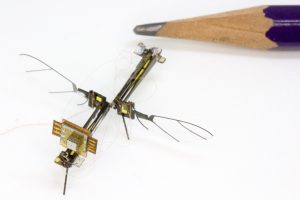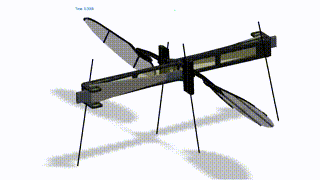
Sensing and Autonomy
We are creating scale-appropriate sensing, control, and autonomy systems for insect robots.
Key challenge: extreme constraints on size, speed, weight, and power (SSWaP) prohibit many approaches that have been successful on larger robots.
Recent articles
• Sensor suite for gnat robots: Fuller, et al., Science Robotics 2022. [see publications page for link]
• Extremely low-power visual flight control for corridor navigation: Yu et al., Intelligent Robots and Systems (IROS) 2022.
• Flight-weight state estimator: Talwekar, et al., Int. Conf. Robotics & Automation (ICRA) 2022 [pdf]
• Custom chip for ultra-low power visual odometry. Shukla, et al., Trans. VLSI 2022.
• Flight-weight pinhole camera: Balasubramanian, et al., BIOROB 2018 [pdf]


Design and Fabrication
We are investigating how to design and build insect-sized robots to expand their capabilities and enable mass manufacture.
Key challenge: physical scaling laws dictate fundamentally different actuation technology, such as piezo actuation and flapping wings vs. electromagnetic motor and rotor.
Recent articles
• Robofly design: Chukewad et al., Trans. Robot 2021. [Link | pdf]
• First 6-DOF Robofly control: Chukewad et al., Robotics and Automation Letters 2021. [pdf] [video]
• Electrohydrodynamic thrust for insect-sized aerial robots: Hari Prasad et al., PLoS One 2020. [link]
• Automatic Robofly trimming system. Dhingra et al., Robotics and Automation Letters 2019. [pdf] [video]

Control and Power
We are investigating how to precisely control the signals for the actuators of an insect robot. We are also investigating how insect robots will power themselves with energy collected from the environment.
Key challenges: Insect robot actuators are largely electrostatic and therefore high-voltage. Manually exchanging or recharging batteries on teams of insect-sized robots is impractical.
Recent articles
• A flight sensing system for robots as they scale down to gnat size: Fuller, Yu, and Talwekar, Science Robotics 2022. [download manuscript on our publications page]
• High-voltage driver with precise amplitude control: James et al., Int. Conf. Robotics and Automation (ICRA) 2021. [pdf]
• Scaling physics favor solar power in small drones. Elkunchwar et al., Int. Conf. Intelligent Robots and Systems (IROS) 2021. [pdf]
• First wireless liftoff of a robotic fly: James et al., Int. Conf. Robotics and Automation (ICRA) 2018. [pdf] [video]

Hybrid Robot-Biology Systems
We are investigating how to take advantage of insects’ superior capabilities to supplement synthetic systems. These include odor sensing or their robust locomotion capabilities.
Key challenge: interconnections between biological and synthetic systems.
Recent articles
• Drone plume source seeking using an insect antenna and fins to steer into the wind: Anderson et al., Bioinspiration & Biomimetics 2020. [pdf]
• Wireless steerable vision system backpack for insects: Iyer et al., Science Robotics 2020. [link]
• Internet-of-things nodes flying on insects: Iyer et al., ACM Mobicom 2019. [pdf]
